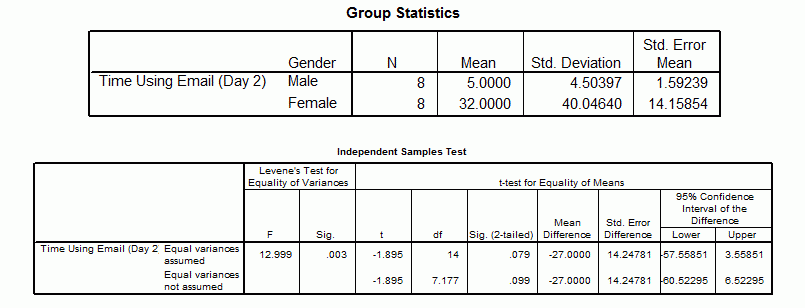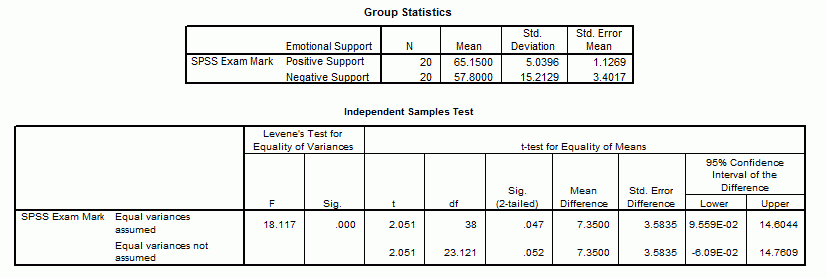An Adventure in Statistics: The Reality Enigma
Student Resources
Chapter 15: Comparing two means
Quizzes are available to test your understanding of the key concepts covered in each chapter. Click on the quiz below to get started.
1. A researcher was interested in the stress levels of lecturers during lecturers. She took the same group of 8 lecturers and measured their anxiety (out of 15) during a normal lecture and again in a lecture in which she had paid students to be disruptive and misbehave. Based on the SPSS output, how would you interpret these results?

- There were no significant differences between anxiety levels in normal lectures and in those in which students misbehaved.
- Anxiety levels were significantly higher in lectures in which students misbehaved.
- We can’t tell any of the above from the output given.
- Anxiety levels were significantly lower in lectures in which students misbehaved.
The correct answer is B. Anxiety levels were significantly higher in lectures in which students misbehaved. This is because we know that anxiety levels were higher when students misbehaved compared to when they were normal because the mean difference (misbehaved – normal) is a positive value. We also know that this difference was significant because the 95% confidence interval does not contain zero, and the p-value (in the column labelled Sig) is smaller than 0.05.
2. A psychologist was interested in whether there was a gender difference in the use of email. She hypothesized that because women are generally better communicators than men, they would spend longer using email than their male counterparts. To test this hypothesis, the researcher sat by the email computers in her research methods laboratory and when someone started using email, she noted whether they were male or female and then timed how long they spent using email (in minutes). What should she report?

- Females and males did not significantly differ in the time spent using email, t(7.18) = –1.90, p = .10.
- Females and males did not significantly differ in the time spent using email, t(14) = –1.90, p = .10.
- Females and males did not significantly differ in the time spent using email, t(7.18) = –1.90, p < .05, one-tailed.
- Females spent significantly longer using email than males, t(14) = –1.90, p < .05.
The correct answer is A. Females and males did not significantly differ in the time spent using email, t(7.18) = –1.90, p = .10.
3. A researcher was interested in the effects of emotion-evoking music on exam performance. Before their SPSS exam, a lecturer took one group of students to a room in which calming music was being played. A different group of students were taken to another room in which the ‘death march’ was being played. The students then did the exam and their marks were noted. The SPSS output is below. The experimenter made no predictions about which form of support would produce the best exam performance. What should he report?

- Students receiving positive music before the exam did significantly better than those receiving negative music, t(38) = 2.05, p = .047.
- Marks for students receiving positive music before the exam did not significantly differ from students receiving negative music, t(38) = 2.05, p = .047.
- Marks for students receiving positive music before the exam did not significantly differ from students receiving negative music, t(23.12) = 2.05, p = .052.
- Students receiving positive music before the exam did significantly better than those receiving negative music, t(23.12) = 2.05, p < .05, one-tailed.
The correct answer is C. Marks for students receiving positive music before the exam did not significantly differ from students receiving negative music, t(23.12) = 2.05, p = .052.
4. An independent t-test is used to test for:
- Differences between means of groups containing the same entities when the sampling distribution is not normally distributed and the data do not have unequal variances.
- Differences between means of groups containing the same entities when the data are normally distributed, have equal variances and data are at least interval.
- Differences between means of groups containing different entities when the data are not normally distributed or have unequal variances.
- Differences between means of groups containing different entities when the sampling distribution is normal, the groups have equal variances and data are at least interval.
The correct answer is D. Differences between means of groups containing different entities when the sampling distribution is normal, the groups have equal variances and data are at least interval. This is sometimes called the independent-measures or independent-means t-test.
5. A researcher measured a group of people’s physiological reactions while watching horror films and compared them to when watching comedy films. The resulting data were normally distributed. What test should be used to analyse the data?
- Wilcoxon signed-rank test.
- Mann–Whitney test.
- Paired-samples (dependent or related) t-test.
- Independent t-test.
The correct answer is C. Paired-samples (dependent or related) t-test.
